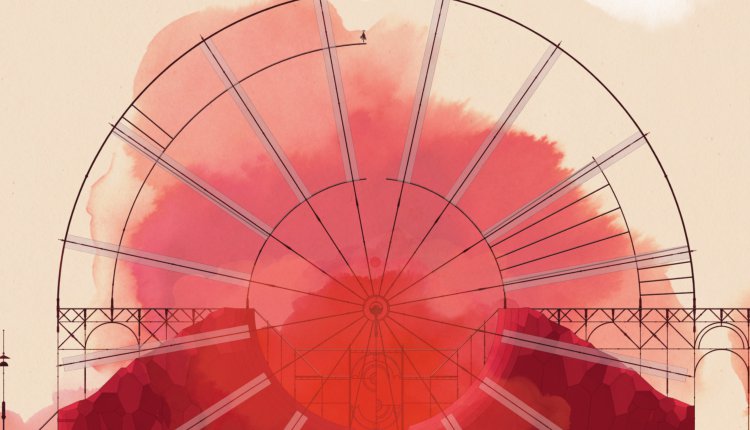Direct a mysterious girl through a watercolor-painted wonderland of geometric complexities in order to recover her lost voice and learn more about herself.
GRIS, by Nomada Studio, is an artistic platformer that starts off a bit different than most games. A singing girl, named Gris, is found sitting in a large stone hand. As her melody continues to soar, so does she, as she lifts into the air — her dress blowing in the wind from this magical energy. Next, Gris somehow loses her voice and the hand begins to crumble around her, sending her into a freefall. When she lands — in a seemingly white canvas of nothing but rocks — she stumbles but slowly comes to a walking pace and sets out to explore the colorless, hand-drawn world.
In this land of stone, little bits of marble move with tiny animated legs across the landscape, bringing signs of life to an otherwise barren ‘scape of structure and form. Your task is to collect geometric points of light in order to fit them into polygonal formations to extend bridges or platforms, or simply bypass a lock system in place. As you search out these ‘stars’, you will also gain powers, which adorn your dress with many abilities, the first of which is to be able to turn the dress into a heavy cube.
The cube form allows you to smash cracked platforms and floors in order to open up pathways to the next area. Jumping adds a bit of momentum to the force, and sometimes additional height by climbing up to higher platforms is required to jump off and smash through certain, stronger cracked spots. You can also use this cube-like form to weigh down platforms, in order to fit shapes into a designated formation or perhaps lift a platform to a desired, accessible height. There are no specific instructions other than an initial button prompt suggesting how to activate this form, which is both frustrating and unique. It’s refreshing to not have large, game-pausing screens showcasing how to the play the game, but at the same time, I could see how this might frustrate some players.

As you continue along, and piece together the constellations, unlocking the different pathways, you will begin to uncover the different colors of this world. As the shapes and structures feel like a nod to Escher and Dali, and even bring to mind at times the stylings of Monument Valley, these colors seem to signify specific emotions and the landscapes that invoke them. The first new environment that you stumble upon is simply defined as ‘Red’, and you are brought into this land with a cutscene showing a watercolor-brushed swirl of crimson washing over the world and painting everything it touches. The whole process is surreal but also so very beautiful, and makes the whole experience seem like a fourth-wall has been broken as someone external is lightly dabbing the hues upon the game’s world.
Music also takes a front stage presence as every action you take — be it collecting stars, climbing terrain or even uncovering a seemingly hidden chasm — brings along an ascension to a beautiful crescendo in each area’s song. When Gris walks upon the constellations created by your progress, her feet seem to dance upon hidden chimes lost to the heavens, furthering the ambience and contributing yet another beautiful set piece in the warm musical tapestry the game weaves together from your journey.

The vista in ‘Red’ is a desert-like world full of raging windstorms. As you are ravaged by strong gales of red wind, a heavy church organ cries out in gothic fashion. In the land following, which is appropriately named ‘Green’, you find yourself in a forest of trees. Their physical form wave in and out like curtains, making platforming on top of them challenging. ‘Blue’ has water everywhere, from the heavy, dreary deluge of rain falling to pools that you must swim through and jump out of to reach otherwise inaccessible areas. Finally, ‘Yellow’ uses light and trickery to envelop the world in a blanket of darkness, a blanket only lifted when you uncover trees and lanterns.
I feel the underlying message in GRIS is an emotional one. As you uncover more about the game’s world, a black, menacing and shape-shifting form sets to ruin your pilgrimage. The different colored lands each seem to represent desperation, melancholy, pain, and ultimately a succumbing to defeat. Starting in the perfect world Gris wakes up to, the game quickly showcases that perfection always has its cracks, budding through the porcelain surface. Of course, there is an eventual triumph, but not without sacrifice.

In a way, GRIS seems to parody life more than any other game I’ve played. It’s surreal art and premise gives way to easy-to-grasp metaphors, but there seems to be something deeper within. The progression and realization of your true purpose isn’t found until you’ve dealt with all the particulars of the emotional rollercoaster that is life. I don’t know what Gris dealt with before the first scene, but I’d like to think that she endured as a better person for it. The breathtaking soundtrack is a perfect complimentary personification of the journey from beginning to end.
GRIS is a relatively short game, finished in an hour or so, but I have never played anything like it, and I would guess that most players haven’t either. It is an emotional journey that feels like a perfect representation of an art game, fulfilling the artist’s purpose through play — a bite-size game that can be played in one sitting, that provides the game’s vision in its entirety. I would certainly recommend GRIS to anyone looking to play something uniquely beautiful, as it is easily one of my favorite games this year.
GRIS is available now on the Nintendo eShop and Steam.